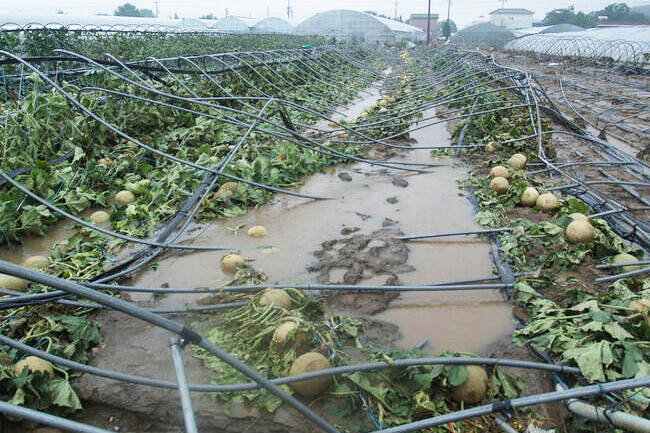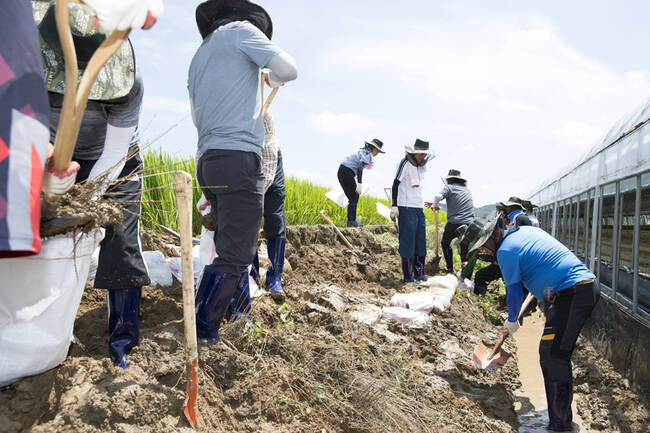South Korea: Amount of the domestic greenhouse gas emission is ‘merely’ reduced in the agriculture sector
The National Assembly Research Service(NARS) recently analyzed the trend of greenhouse gas emissions in Korea, between 1990 and 2017, through a report titled "Impact of Climate Change in the Agricultural Sector and Current Status and Implications of Greenhouse Gas Emissions”. According to this recent analysis by the NARS, greenhouse gas emission in the agricultural sector accounted for 2.9% of the total greenhouse gas emission in 2017 and only decreased 4.3% in the past 27 years.

On Wednesday, September 2, Typhoon Masak hit southern parts of South Korea with heavy rains and strong winds, flooding streets, causing power outages and grounding hundreds of flights. This is after the eighth typhoon “Barbie”, also the longest-ever rainy season and flood pummeled the central region of the country. Weather disasters such as typhoons are largely due to global warming by increased sea level temperatures. This is why greenhouse gases that cause global warming are regarded as significant threat. Although greenhouse gas emissions increase every year in Korea, it is noteworthy that emissions in the agricultural sector have decreased. Forests and grasslands have been identified as the only resources to absorb greenhouse gases.
The National Assembly Research Service recently analyzed the trend of greenhouse gas emissions in Korea between 1990 and 2017 through a report titled "Impact of Climate Change in the Agricultural Sector and Current Status and Implications of Greenhouse Gas Emissions”. According to the report, greenhouse gas emissions (based on carbon dioxide conversion) in the agricultural sector fell 600,000 tons from 21 million tons in 1990 to 20.4 million tons in 2017. During the same period, the country's overall greenhouse gas emissions increased sharply from 292.2 million tons to 79.1 million tons.
The proportion of the agricultural sector in the country's greenhouse gas emissions fell 4.3 percentage points from 7.2 percent in 1990 to 2.9 percent in 2017. Compared to the previous year, 2017 emissions increased in all areas, including industrial processes (6%), energy (2.2%), and waste (2%), while the agricultural sector was the only one with a 0.3% decrease.
In the agricultural sector, greenhouse gas emissions have decreased since 1990 as rice cultivation has continued to decrease. The amount of greenhouse gas emissions in the farming sector (where grinding and seeding the land take place) changed from 15.4 million tons in 1990 to 11.8 million tons in 2017. In other words, the methane produced in the process of growing rice has decreased by that much.
The livestock sector, which is known to emit a lot of greenhouse gases, has also seen its growth decline since the outbreak of foot-and-mouth disease in 2010. Livestock greenhouse gases increased from 5.6 million tons in 1990 to 8.7 million tons in 2010, but slowed down to 8.6 million tons in 2017.
Some ecological resources were the only ones in the country to absorb carbon dioxide. In 2017, 45.7 million tons of greenhouse gases were absorbed by forests and grasslands. However, such absorption has been on the decline since the peak at 61.9 million tons in 2000, therefore renewing the species of trees need to be considered.
Meanwhile, the report said that the average annual temperature rose from 12.1°C to 12.9°C over 30 years and the average annual precipitation increased from 901.6 mm to 1,451 mm after examining changes in weather conditions in Korea between 1988 and 2018. It also analyzed that the average annual sunshine time decreased from 2410.6 hours to 2,382.1 hours, which is likely to affect the productivity and quality of crops.
The greenhouse gas emissions from the agriculture sector are as low as 2.9% of the nation’s total greenhouse gas emission. Despite this and due to the warming phenomenon around the Korean Peninsula, frequent agricultural disasters are on the rise. These are caused by torrential rains, typhoons, abnormal low temperatures, heat waves, droughts and floods.. This report therefore emphasized to establish appropriate measures urgently followed by upgrading the climate prediction system and in this way to reduce agricultural disasters and to manage difficulties in growing crops and farming in the sector. It also urges the government to establish a policy master plan accordingly to ensure the sustainability in the agriculture sector.

Source: Report of the NARS [Impact of Climate Change in the Agricultural Sector and Current Status and Implications of Greenhouse Gas Emissions] / Farmers News on 31 August 2020